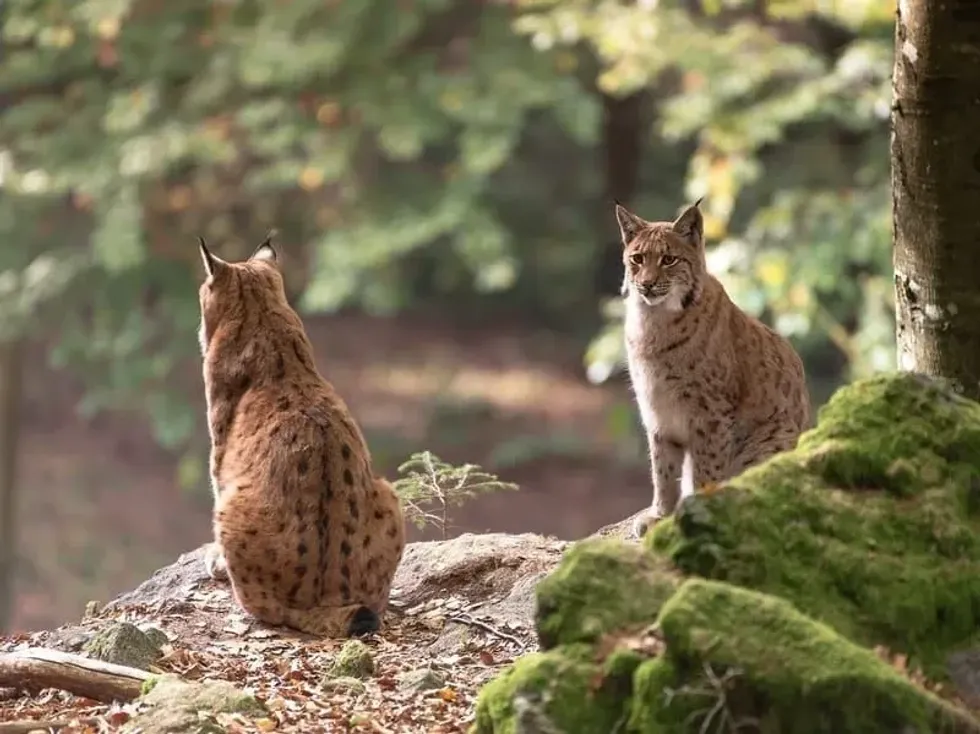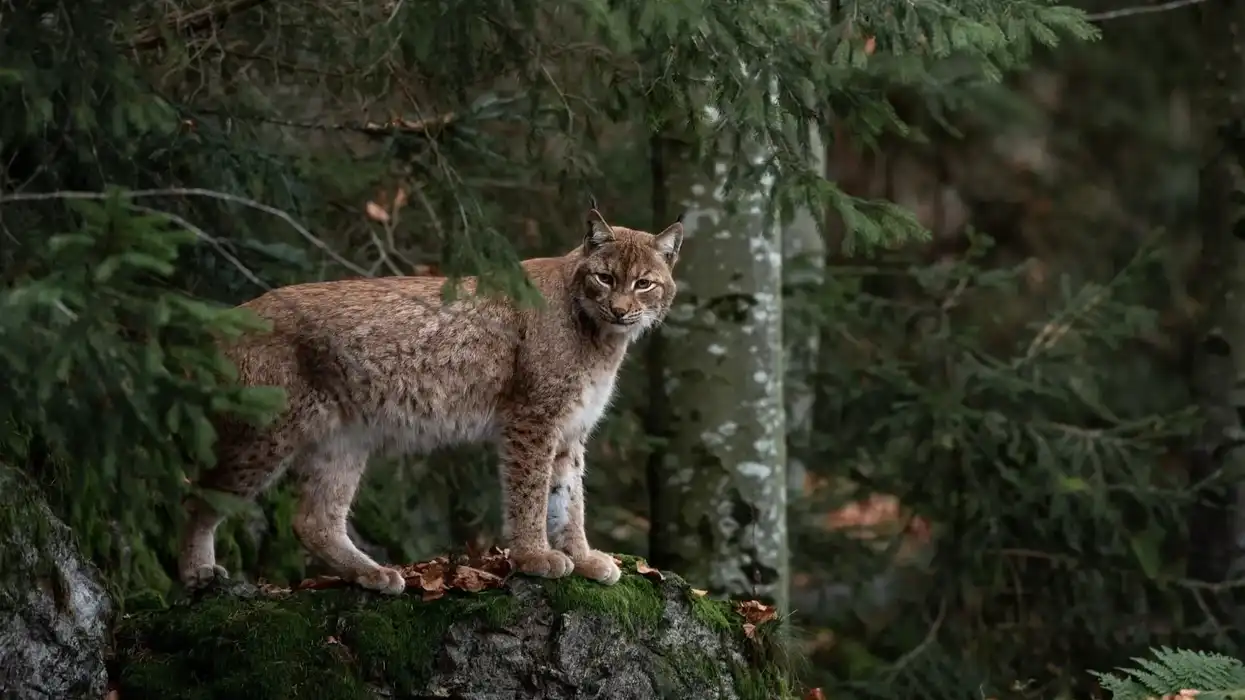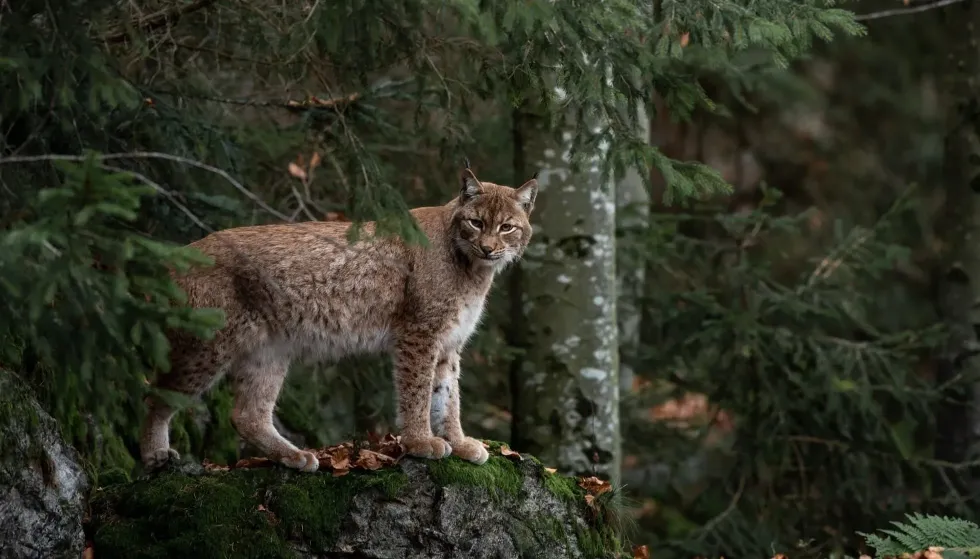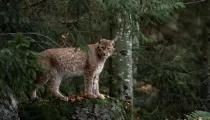Fun Bobcat Facts For Kids

Content
- What type of animal is a bobcat?
- What class of animal does a bobcat belong to?
- How many bobcats are there in the world?
- Where does a bobcat live?
- What is a bobcat's habitat?
- Who do bobcats live with?
- How long does a bobcat live?
- How do they reproduce?
- What is their conservation status?
- What do bobcats look like?
- How cute are they?
- How do they communicate?
- How big is a bobcat?
- How fast can a bobcat run?
- How much does a bobcat weigh?
- What are the male and female names of the species?
- What would you call a baby bobcat?
- What do they eat?
- Are they dangerous?
- Would they make a good pet?
- Did you know...
- What does a bobcat sound like?
- When are bobcats most active?
The bobcat (Lynx rufus) is a species of cat that is commonly found in the southern half of North American habitats. They are common and adaptable predators that are closely related to the larger and more northern Canadian lynx species, with the most notable difference being the bobcat's short 'bobbed' tail.
The seemingly bobbed tail of this cat species is the characteristic due to which this cat's common name is a bobcat.
The bobcat is smaller than the Canadian lynx, with smaller paws and ear tufts, and is usually darker in color.
Cats living in mountainous forests are darker with more markings than their lighter-colored cousins of the cat family found in more arid, semi-desert areas. There are currently 12 recognized subspecies of bobcat, which differ in coloration and geographic distribution.
Bobcats are carnivores. The diet of these cats consists of small rodents like rabbits, squirrels, moles, and rats.
Birds and snakes are also occasionally a part of their diet. Deer are the largest predators that bobcats have been known to hunt and eat.
Bobcats only prey between the hours of twilight and dawn. Bobcats are crepuscular, meaning they are most active at dusk. They move from three hours before sunset to around midnight and then from before dawn to three hours after sunrise.
They follow their usual route of 2-7 mi (3.2-11.3 km) each night. This behavior will change with the seasons, as bobcats become more active during the daytime in winters as a result of their prey's increased activity during the day in colder weather.
Here on our page, we have lots of amazing facts about bobcats that everyone will enjoy. Let's look at these interesting facts; if you like these, then do read our Bengal tiger and Sumatran tiger facts.
Bobcat Interesting Facts
What type of animal is a bobcat?
Bobcats belong to the Lynx species of the cat family.
What class of animal does a bobcat belong to?
Bobcats belong to the Mammalia class of animals.
How many bobcats are there in the world?
The exact population across the world of these cats is unknown, but their population in all of the United States is said to be in the range of 2-3 million.
Where does a bobcat live?
The bobcat habitat range is very wide. It ranges from mountainous forests to semi-arid deserted areas. Throughout the natural range of the habitats of these cats, they can be found in a variety of places, such as coniferous forests, mountain woodlands, deserts, marshy lands, and even residential areas in some cases.
What is a bobcat's habitat?
The bobcat is the most commonly spread of all North American cats and is found throughout North America in southern Canada, the United States, and right down to southern Mexico. They are a highly adaptable species that has adapted to living in a wide range of environments across three countries.
The bobcat's precise appearance is determined by the type of environment it inhabits. The various coat colors help the organism blend in as much as possible with its surroundings.
Its historical range once spanned the whole of North America. The bobcat's range seems to be restricted by habitat availability rather than human populations.
In the edge of urban areas, where human growth intersects with natural ecosystems, it can be home to this cat. When a dog chases it, it normally scales a tree.
Who do bobcats live with?
Bobcats are lonely creatures that like to live alone. Females choose a secluded den to live in and raise a litter of one to six young kittens, who will stay with their mother for nine to 12 months.
These wild cats will learn to hunt for prey through this period before venturing off to hunt on their own. People hunt bobcats in some areas for their soft, spotted fur.
How long does a bobcat live?
A bobcat's life span is around eight to 12 years. The oldest wild bobcat to live died at the age of 16.
How do they reproduce?
These cats are polygamous and begin to mate during late winters. Female bobcats can start breeding as early as their first year.
Each year, sperm development starts in September or October, and the male remains fertile during the season. A dominant male bobcat calls and travels with a female and mates with her many times, usually from winter to early spring; however, this varies by region, and the majority of mating occurs in February and March.
The pair can engage in a variety of activities, such as bumping, chasing, and ambushing.
Other male bobcats may be present, but they are uninvolved. If the male has determined that the female is receptive, he grabs her by the neck and mates with her.
Males usually mate with multiple females, so the female can later mate with other males. Bobcats are usually quiet, but while mating, they scream, hiss, and make other sounds.
The female is the primary fetcher of food and responsible for hunting for her kittens in their early life. After 60 to 70 days of gestation, one to six kittens, typically two to four kittens, are born in April or May.
Sometimes, second litters of bobcat kittens are born as late as September. The female bobcats normally give birth in a small cave or hollow log that is sealed.
By the ninth or tenth day, the bobcat kitten opens their eyes.
After these cats open their eyes, at four weeks, the kittens begin exploring their surroundings, and at two months, the kittens are weaned. They start traveling and hunting with their mother in three to five months.
They hunt for food by themselves by the fall of their first year and normally scatter shortly afterward. However, in Michigan, the kittens have been seen living with their mother as late as the next spring.
What is their conservation status?
The conservation status of these cats is of Least Concern with no major threats to their survival.
Bobcat Fun Facts
What do bobcats look like?

The bobcat is similar to other animals of the Lynx family, but it is the smallest of the four wild animals. These cats have a tan to grayish-brown fur coat with black streaks on the body and dark bars on the forelegs and bobcat tail.
Due to extended hair beneath the head, the face tends to be large. The eyes of a bobcat are yellow with round, black pupils.
A bobcat's nose is pinkish-red, and its face, sides, and back are orange, yellowish, or brownish-red in color. The pupils are round, black circles that expand to increase light reception during nocturnal activity.
The cat has excellent hearing and vision, as well as an incredible sense of smell. It can climb well and swim when necessary, but it prefers to stay out of the water.
Camouflage is provided by the spotted patterned bobcat prints of these wild animals. The ears are pointed and black-tipped, with small black tufts.
The lips, jaw, and underparts of these wild cats are typically off-white. The bobcat's underside is white, making the darker spots stand out more, and their short, black tail, which only grows to about 5.9 in (15 cm) in length, has a white tip.
A bobcat's footprint is small as compared to other animals of the Lynx genus. A bobcat's skull is also small as compared to animals of the Lynx genus.
How cute are they?
Bobcats are beautiful and majestic animals. A bobcat cub is very cute and might be rated as high as nine on a scale of 10.
Wondering what the difference between a lynx and a bobcat is? They are very similar, but a Lynx has longer legs and larger feet. Of course, the bobcats also have a 'bobbed tail', which the Lynx doesn't, which makes bobcats all the cuter.
How do they communicate?
The scent, visual cues, and vocalizations are all used by bobcat populations to communicate. They also urinate along travel paths, dump feces in latrine sites, and scrape urine and feces along trails to leave a scent trace.
These markings are used to deter other bobcats. Bobcats rarely use visual cues.
These markings may mean that a female and her kittens are using the nest, indicating that a female is receptive to mating, or mark a home or hunting range. Close-range cues such as body postures and facial and tail movements are used to ward off intruders.
Bobcats rarely meow like house cats; instead, they rely on chirping and chortling. During the breeding season, the vocalization of bobcats sounds like a domestic alley cat crying, which is the bobcat call.
How big is a bobcat?
This animal reaches an average bobcat size of around 25-40 in (65-100 cm) in its life. A bobcat footprint is similar to a dog footprint. Bobcats are twice as big as normal house cats.
How fast can a bobcat run?
Bobcats can run as fast as 34 mph (54.7 kph) while hunting for food.
How much does a bobcat weigh?
The weight of a bobcat is around 9-33 lb (4.1-15.3 kg).
What are the male and female names of the species?
There are no specific names for male bobcats and female bobcats.
What would you call a baby bobcat?
There is no specific name, but a baby bobcat is also called a kitten or a cub.
What do they eat?
Bobcats like to hunt for small animals like rabbits as they like to eat such animals. The bobcat diet usually consists of squirrels, birds, mice, and rabbits.
However, they can also eat big animals like deer, especially during the winter season, and store them for future meals if prey availability is limited. They also occasionally prey on household pets like cats, small dogs, and rabbits.
Are they dangerous?
Bobcats are very, very shy and often friendly. They shy away from interaction, especially with humans, and rarely get aggressive. If a bobcat is rabid, it may act impulsive and erratic.
If you do see a bobcat, make sure you avoid any interaction. Maintain a safe distance, protect any kids or pets around, spray water at it if possible or make loud banging noises to scare it away. Make sure you do not run away because that would encourage the bobcat to follow and pursue you.
Would they make a good pet?
Bobcats might not be the best for pets as it is dangerous and difficult to tame bobcats, but a pet bobcat is not an impossible task. Some people keep them as exotic pets.
They make great pets for the right owners who know how to handle them. If you're looking to attract or lure them in, using a combination of catnip, whistle, anise oil, or minerals will help.
Did you know...
The haematoprotozoan parasite, Cytauxzoon felis, causes Cytauxzoonosis, also known as bobcat fever, which is an acute, frequently lethal, tick-borne illness. Cytauxzoonosis is a disease that generally affects stable, young adult cats that have access to or live outside.
Bobcat tracks are 2 in (5.08 cm) in diameter and look like a small dog's tracks, except for a small notch in front of the heel pad in the track's dead middle. The front paws of a bobcat are significantly bigger than the back feet.
The haunting cry of bobcats can be heard from miles away.
A male bobcat has personal territories that can be up to 30 sq mi (77.69 sq km), while females can be up to five sq mi (12.9 sq km). Their urine and feces distinctly identify these territories.
Bobcats have keen eyesight and ears, as well as a well-developed sense of smell.
Bobcats, unlike domesticated house cats, love being in the water and are excellent swimmers.
A bobcat hybrid of a lynx and a bobcat is called a Lynx or Lynx cat.
When chasing their prey, bobcats effortlessly navigate through rocky terrain and scale tall trees, thanks to their incredible climbing skills.
Cougar vs. bobcat: The cougar is a bobcat predator, which is sometimes twice as big as a bobcat.
The bobcat is the most common and has the most variety of all the wild cats in North America.
Bobcats are stealthy hunters who pounce on their victims. They can jump over 9.8 ft (3 m) in length. They can also hunt down prey by hitting speeds of up to 31 mph (50 kph) in fast bursts until they get near enough, but they are unable to maintain this speed for longer distances.
The bobcat and the coyote are twinned in Native American mythology to reflect duality.
A bobcat skull sells on the dark web and other black markets.
Bobcat poop is 4 in (10 cm) long, usually characterized by blunt ends. These cats try to cover up their poop with soil or leaves.
A bobcat pelt or a fur coat can retail up to a shocking $150,000!
What does a bobcat sound like?
Bobcats (Lynx rufus) rarely meow like house cats; instead, they chirp and chortle. During the breeding season, their vocalizations sound like a domestic alley cat crying. Bobcats are usually quiet, but while mating they scream, hiss, or make other sounds.
When are bobcats most active?
The bobcat is crepuscular, meaning it is most aggressive at dusk and does not sleep at night. It moves from three hours before sunset to around midnight and again from before dawn to three hours after sunrise.
Any night, bobcats follow a well-worn path that varies in length from 1.86-6.83 mi (3-11 km).
Bobcats, like most species, are territorial and prefer to be alone. This behavior changes with the change in seasons, as bobcats become more diurnal in the fall and winter in response to their prey's increased presence during the day in colder weather.
Here at Kidadl, we have carefully created lots of interesting family-friendly animal facts for everyone to discover! Learn more about some other mammals from our fainting goat facts, or woodchuck facts pages.
You can even occupy yourself at home by coloring in one of our free printable bobcat coloring pages.
We Want Your Photos!
More for You
See All
Bachelor of Commerce specializing in Accounting and Finance, Master of Business Administration

Divya RaghavBachelor of Commerce specializing in Accounting and Finance, Master of Business Administration
With a diverse range of experience in finance, administration, and operations, Divya is a diligent worker known for her attention to detail. Born and raised in Bangalore, she completed her Bachelor's in Commerce from Christ University and is now pursuing an MBA at Narsee Monjee Institute of Management Studies, Bangalore. Along with her professional pursuits, Divya has a passion for baking, dancing, and writing content. She is also an avid animal lover who dedicates her time to volunteering for animal welfare causes.
Bachelor of Arts specializing in History

Isobel MurphyBachelor of Arts specializing in History
With a love for exploring cities and finding outdoor spaces to enjoy, Isobel has spent her life exploring various cities in the UK, from her hometown of Surrey to Birmingham where she studied history for three years. She is passionate about sports and enjoys watching and playing, as well as baking and spending quality time with her loved ones.
Disclaimer
1) Kidadl is independent and to make our service free to you the reader we are supported by advertising. We hope you love our recommendations for products and services! What we suggest is selected independently by the Kidadl team. If you purchase using the Buy Now button we may earn a small commission. This does not influence our choices. Prices are correct and items are available at the time the article was published but we cannot guarantee that on the time of reading. Please note that Kidadl is a participant in the Amazon Services LLC Associates Program, an affiliate advertising program designed to provide a means for sites to earn advertising fees by advertising and linking to Amazon. We also link to other websites, but are not responsible for their content.
2) At Kidadl, we strive to recommend the very best activities and events. We will always aim to give you accurate information at the date of publication - however, information does change, so it’s important you do your own research, double-check and make the decision that is right for your family. We recognise that not all activities and ideas are appropriate for all children and families or in all circumstances. Our recommended activities are based on age but these are a guide. We recommend that these ideas are used as inspiration, that ideas are undertaken with appropriate adult supervision, and that each adult uses their own discretion and knowledge of their children to consider the safety and suitability. Kidadl cannot accept liability for the execution of these ideas, and parental supervision is advised at all times, as safety is paramount. Anyone using the information provided by Kidadl does so at their own risk and we can not accept liability if things go wrong.
3) Because we are an educational resource, we have quotes and facts about a range of historical and modern figures. We do not endorse the actions of or rhetoric of all the people included in these collections, but we think they are important for growing minds to learn about under the guidance of parents or guardians.







